 |
 |
 |
http://www.varalaaru.com A Monthly Web Magazine for South Asian History [179 Issues] [1772 Articles] |
 |
 |
 |
http://www.varalaaru.com A Monthly Web Magazine for South Asian History [179 Issues] [1772 Articles] |
|
Issue No. 45
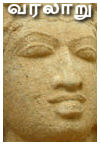
இதழ் 45 [ மார்ச் 16 - ஏப்ரல் 17, 2008 ] 
இந்த இதழில்.. In this Issue.. 
|
Series:
Pudukkottai Cave Temples
Hi Readers,
I am again with another travelogue. This time we went to Malayadipatti an important place of 1200 years old monuments. I obliged to thank all who have commented on my previous travelogue and feel very excited and conscientious to give an authentic account in interesting way. Malayadippatti, a small village lies on the northern block of Kulattur Taluk in Pudukkottai district is noteworthy for its two rock cut temples. It is on the Keeranur - Killukottai route, about 10 kms from Keeranur. One can also reach Malayadipatti through Tiruchirappalli - Thanjavur highway by taking diversion to right near Asur and it is approximately 20kms from there. On 30-12-2007 we made our first visit to the Malayadipatti. We went through Keeranur and from there we traveled on Killukkottai road. At first we went to Varasugisvaram Shiva temple at Visalur, which is a structural temple. After breakfast we proceeded to Malayadipatti, which is just 5 kms from there. Unlike the interior parts of Pudukkottai District the northern blocks are fertile due to their proximity to Delta regions. But these areas are not under river irrigation, water requirement is met out by well and pond. In many places we can come across small and big tarns where rainwater harvest is done, which are the main sources for cultivation and other purposes. During our first visit at that time we saw on either side of road fields filled with lush green paddy crops, cane sugar and very rarely turmeric crop. It was a feast for the eyes. It reminds me a song in Mukkudarpallu that picturizes the fertility of Seevalamangai Thenkarai nadu. பங்கயம் தலைநீட்டிக் குரம்பினில் பச்சை இஞ்சியின் பாசடை தீண்டும் தங்கும் இஞ்சியும் மஞ்சட் கழுத்தைத் தடவி மெள்ளத் தொடுமந்த மஞ்சள் அங்கு அசைந்திடும் காய்கதிர்ச் செந்நெல் அளாவி நிற்குமச் செந்நெலும் அப்பால் சீவல மங்கைத் தென்கரை நாடே. We made our second visit on 03-02-2008 and it was harvesting season. Within a month the emerald fields turned into pale yellow with matured crops stooping downwards and in some places the harvest was over. Cane sugar and dry crop cultivation is prominent in these areas. As Malayadipatti is also one of the northern block villages, is surrounded by trees, paddy fields, small tarns that picturize its fertility. At the end of the village cluster of small rocky hillocks and boulders are seen. Some of the hillocks are very small which can be claimbed easily. In one of the rocky hillock which remains close to the main road are seen the two rock-cut temples namely Olipathivishnu graham for Vishnu and Alathurthali for Shiva. Natural caverns with beds are found around here. 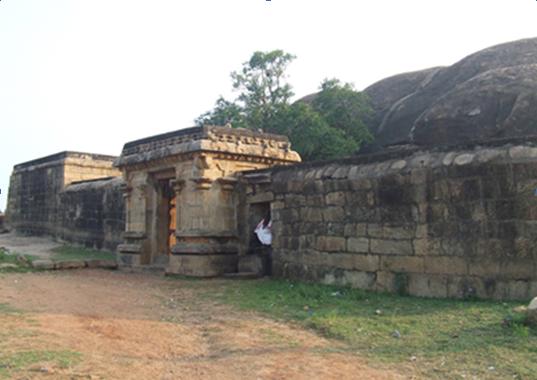 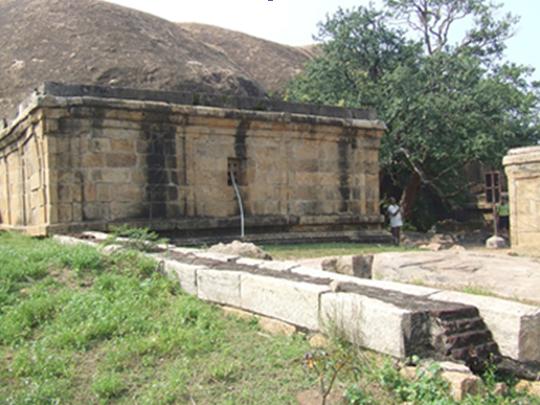 The small hillock runs east-west direction, on which the two rock-cut temples are excavated facing north. The Vishnu cave is excavated on the western end of the rock whereas the Shiva cave is on the eastern end of the rock. The Vishnu cave is enclosed by compound wall on all sides, whereas, for the Shiva cave the compound wall extends upto the structural shrine in the northwest and for the remaining portion is left with the basement only. As these temples are very famous in and around the neighboring villages, daily pujas are conducted in the morning for the devotees. They are under the control of ASI and the temples are opened for visitors from morning 6 am to evening 6 pm. In this edition I dealt with Alathurthali, the cave temple that houses the deities Vagisvara Nayanar and his consort Vadivulla Mangai. 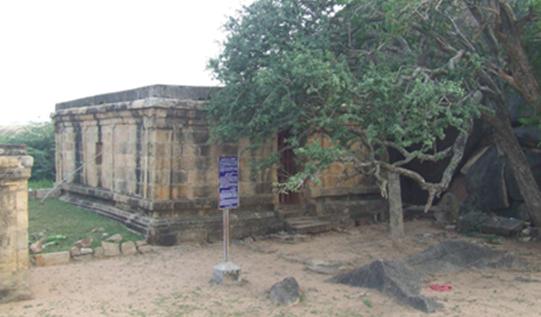 The Shiva cave temple, which lies little higher to the Vishnu cave is on the eastern end of the rock facing north. This temple complex consists of a rock-cut mandapa with a cubical sanctum in the eastern end and a later constructed pillared mandapa in front and two other structural subshrines facing South. Unlike the usual characteristic feature of a rock-cut architecture with a separate rectangular mukhamandapa and a cubical sanctum this cave temple is of different style with a sanctum cut inside the mandapa. The cave and the front mandapa are enclosed by a compound wall, which ends adjoining the mother rock. 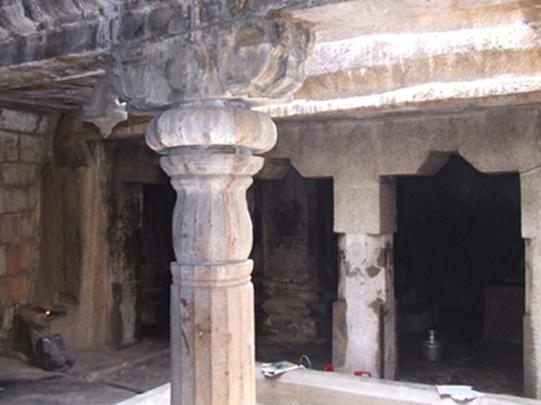 The front pillared mandapa surrounded by a compound wall is having an entrance in the west. One can reach the cave, which is to the south of the mandapa only by entering the mandapa in the west. There are four pillars in the middle of the mandapa, which are Indrakantha in style with pada and inverted padma as the base. Above the padma is seen the Indrakantha shaft, kattu, kalasa, tadi and kudam. The Potika with madalai at four ends and the spout extension called nanudal with a small bud on both ends. Circular medallions are incised on the faces of the potika. The two rear pillars are connected with an arch brick work inside which idols of Muruga and Vinayaga are kept on a raised platform. 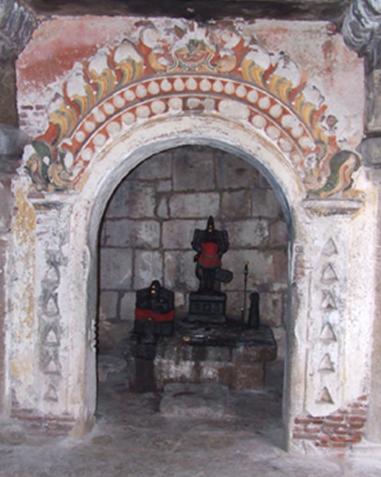 The main cave consists of a facade and a rectangular mandapa facing north and a cubical sanctum cut on the eastern end of the mandapa facing west. The eastern and southern wall of the mandapa constitutes the hind and sidewall of the sanctum. 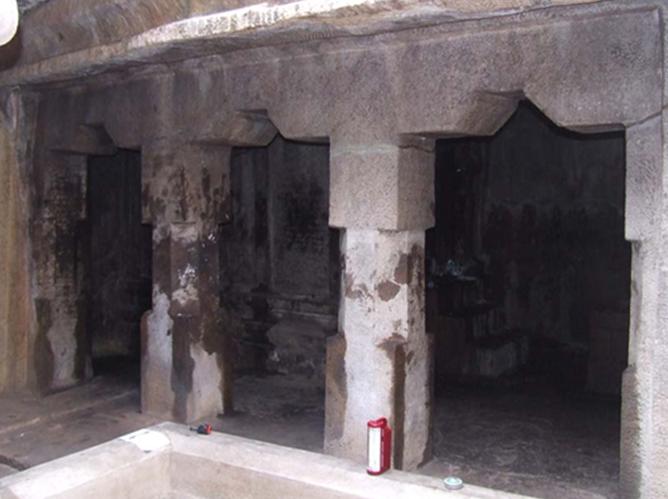 The facade of the mandapa measures 4.64mts in east-west and .64mts in north-south. It consists of two pillars in the middle and two pilasters on both ends. The pillars and pilasters are squares at the ends and have a kattu in the middle. Above the pillars and pilasters lies the angular potika holding the uttira and a thin vajana that runs on both the sides of the facade wall. The mother rock, which extends beyond the facade forms the kapota where the canopy is neither flat nor concave. Above the kapota on outer side of the mother rock an unfinished attempt is seen. 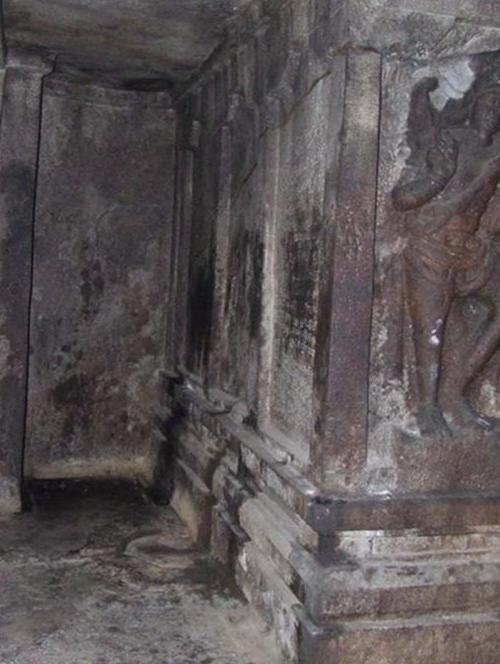 Inside the mandapa, for the uttira above the facade pillars and pilasters, two rows of line demarcation is seen. Beyond the eastern pilaster of the facade the mother rock extends upto a length of .60mts, which is absent in the western end. In the space between the eastern wall of the mandapa and the eastern pilaster, inside the mandapa facing south approximately to a height of 4mts from ground level a basrelief sculpture of Chandeshwara is cut. The Chandeshwara seated in suhasana with jatabara with knot in the centre and patrakundala, sarapalli, yajnopavita in nivita, left hand on the thigh and right hand is holding parasu. The vajana cut in the facade runs through out the mandapa. 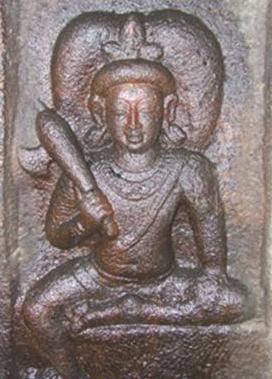 The rectangular mandapa measure 6.70mts in north-south and 4.58mts in east-west direction. The sanctum is cut on the eastern end with the distance of 1.10mts from the facade, the saptamatrika panel occupies the south wall, a panel of deities occupies the western wall. In the middle of the mandapa, a nandi is seen on a raised pedestal facing the sanctum. A hole as an outlet is cut in the northern shrine wall of sanctum, under which in the mandapa floor a semicircular cut is made for the proper flow of water in the floor. 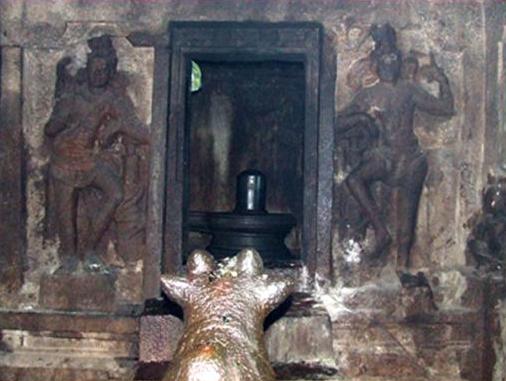 The adhistana of the sanctum is .72mts height from mandapa ground level and of padabanda type with the features of upana, jagadhi, octagonal kumudha, gala and pada flanked by kambu on either side, pattika and uparikambu above. The sanctum extends 3.13mts east-west and 3.40mts north-south inside the mandapa. The front wall of the shrine is adorned with four pilasters, with the middle pair flanking the shrine entrance. Likewise the northern wall of the shrine is also partitioned with four pilasters. The northern end pilaster which also constitutes the western end pilaster of northern wall is the only pilaster having four faces, and the rest being of three faced. The pilasters are plain with angular potika holding the uttira and vajana above. On either side of the shrine entrance, dvarapalakas are shown in the niches, formed between the pilasters. The shrine entrance has a doorframe with jambs, lintel and sill. Ornamental works are present on the jambs and lintel. Kanda and pada features are shown in the lintel. A flight of four rock cut steps leads us to the sanctum, of which the lower most step is shown as Chandrakal. The cubical sanctum measures 2.11 mts north-south and 2.10mts in the east-west direction. The height of the sanctum is 1.90mts with the demarcation of uttira and vajana in the wall. In the centre of the sanctum is seen Lord Shiva in the form of linga cut out of mother rock. The circular avudaiyar of the linga is .45mts height and the rudra bana is .34mts with a long Gomukha facing north. The avudaiyar has the features of upana, rudra kumuda, kandam with kambu on either side, pattika and upari kambu. All the features above the upper kambu extends to the spout also. 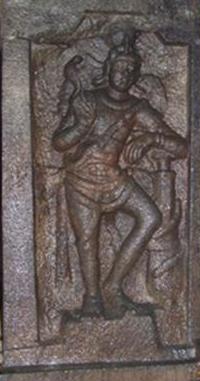 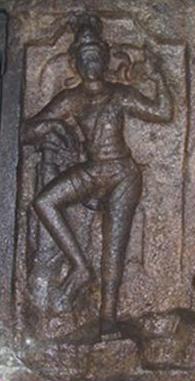 Both the basrelief sculptures of dvarapalakas are the depiction of Shiva’s weapons mazhu and tirisulam as Mazhuvadiyar and Tirisulakar respectively. The dvarapalaka to the left of the entrance is 1.71mts height with tirisulam shown in the top portion of the makuta, whereas the one to the right of entrance is 1.66mts height with axe shown in the makuta. Both are standing in sama with their inner leg turned towards sanctum, but the Tirusulakar placed his raised right leg in Tryasra in front of the club. Karandamakuta adorns their head. Patrakundalas, charapalli, udarabanda and anklets are the ornaments found. Thick yajnopavita in upavitha is seen. Side tusks are shown for Mazhuvadiyar. Both are wearing short dress with idaikattu and thick knots hanging on the sides. Both are decked with bangles. Both the dvarapalakas stretched their inner hand on a heavy club coiled with snake and the left hand of Tirisulakar is in vismaya whereas the right hand of Mazhuvadiyar is in dvajani mudra. A hooded snake is seen above the shoulders of both the dvarapalakas. 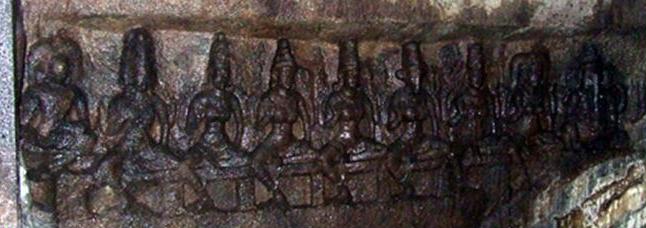 The basrelief sculptures of Saptamatrika panel is on the south wall of the mandapa. The panel is cut in the height of .82 mts from ground level and the height of the panel is .84mts extending for about 3.15mts in east- west direction. The seven goddesses are seen in between Veerabathra on the eastern end and Ganesha on the western end. All the deities are shown seated on a pedestal. Except Ganesha and Veerbadra all the seven deities are seated in suhasana with their left leg placed on the platform on folded position and right leg hanging down. Their front right hand is in abaya and front left hand is on their thigh. All the goddesses are clad in pattadai upto their ankle with the knots shown on the sides and except Chamunda all are wearing breast band with shoulder belt. Sannaveeram is shown for Kaumari and the rest of the deities are shown with yajnopavita. Their respective flag is shown behind them. 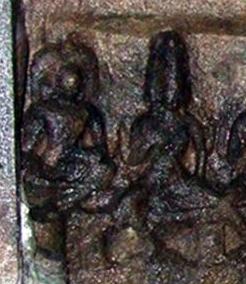 Veerabathra Veerabathra is seen on the eastern end of the panel adjacent to southern dvarapalaka. Jatabara adorns his head and legs are crossed with yogapatta around, front right hand is in abaya and front left hand is in on the thigh. The back hands holds the parasu and deer. The ornaments and other features of this sculpture is not clear as it is much wornout. Nanmukhi Next to Veerabadra is Nanmukhi with annam flag. Jatamakuta adorns the heads and the makarakundalam is the only ornament visible. Maheshwari Nandi flag is shown for Maheshwari. Jatamakuta adorns the head and the back hands are holding deer and parasu. Makarakundalam, kandigai, sarapalli, anklets are the ornaments seen. Kaumari Peacock flag is shown for Kaumari and the back hands are holding akkamalai and sakthi. Karandamakudam with chenni adorns the head, patrakundalam, sarapalli, bangle, armlets and anklets are the ornaments seen. Svarnavaigaksham is shown for Kaumari. 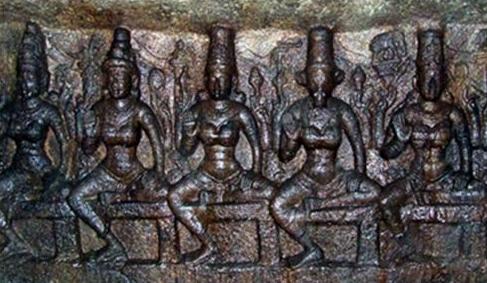 Vaishnavi Garudan flag is shown to Vaishnavi with garudan hands together in praying posture. The back hands holds prayogachakra and sangu. Kritamakuta adorns the head, makarakundalam, sarapalli, kandigai, bangles, armlets and anklets are the ornaments found. Varahi Plough flag is shown for Varahi and the back hands hold sangu and chakara. Kritamakutam adorns the head, sarapalli, bangles, armlets and anklets are the ornaments found. On both sides above the nose side tusks are shown. Indirani Elephant flag is shown for Indirani and the back hands holds angusam and akkamalai. Kritamakutam adorns the head, sarapalli, makarakundalam, bangles, armlets and anklets are the ornaments found. 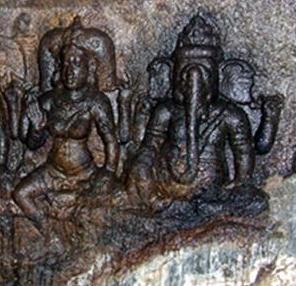 Chamundi Owl flag is shown for Chamundi and the back right hand holds a knife and the left hand is in vismaya. Heavy jatabara adorns the head with decorative pendant plate in the centre and patrakundala, sarapalli, kandigai, bangles, amrlets, sathangai are the ornaments found. Ganesa Ganesa seated in maharajalilasanam forms the last sculpture of the panel. Karandamakuta adorns the head, back hands holds the tusk and sugarcane with leaves. The front left hand is on the thigh and the right hand holding a motaka rests on the right knee. The yajnopavita is in upavita style, utarabandam, armlet, bangles, sarapalli are the ornaments found. The trunk is in valampuri holding a motaka. 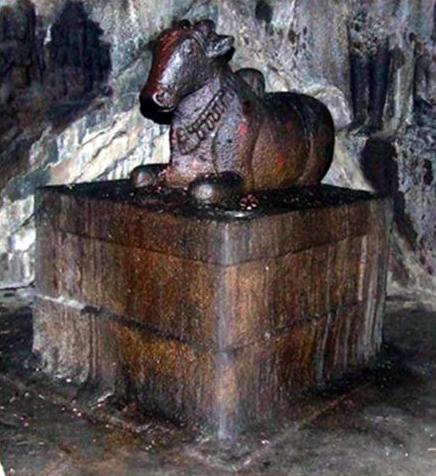 In the middle of the mandapa nandi is seen seated on a raised platform facing the sanctum. Both the Nandi and the platform is cut out of mother rock. The pedestal is .74 mts height with 1.01mts in east west and .99mts in north south direction having the parts of upana, kanda and pada complex and vajana. The nandi is decorated with a garland of bells and beads. 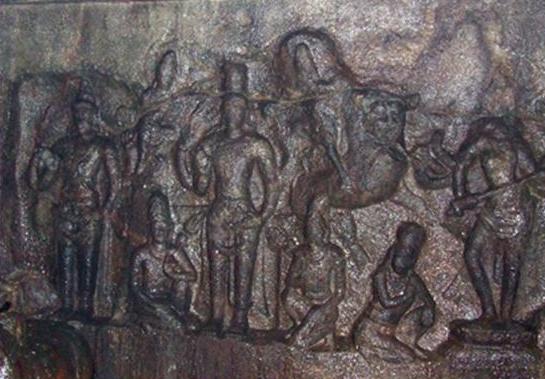 This basrelief panel which occupies the whole western wall of the mandapa is cut in about .81mts height from ground level. The panel measures 3.42mts in north south direction to the height of 1.77mts. It starts with Muruga in south end, Sankaranarayana and the lion vehicle of Korravai occupies the central part of the panel. Devotees are depicted in the lower part of the panel, whereas Suryan and Chandran are depicted in upper part in flying posture. With Korravai and deer in the northern end the panel completes. Due to human vandalism and innate nature of the stone this panel is defaced to a certain extent. 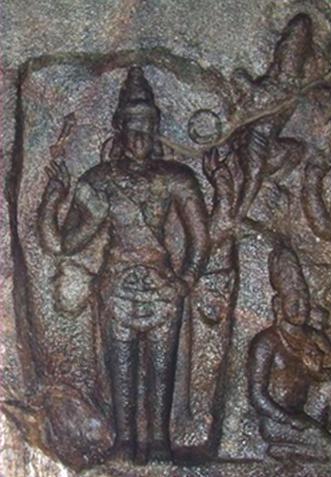 Muruga standing in sama found on the southern end of the panel. Karanda makuta and chenni adorns his head with hair flowing on the sides. The back hands holds the vajram and akkamalai, whereas the front right hand is in abaya and left hand in kadiyavalambitham. He is wearing a short dress with belt holding the dress in the waist and idaikattu with heavy knots flanking on both sides. Channaviram a unique feature to muruga is seen around his chest whereas patrakundala, sarapalli, bangles and udarabanda are other ornaments found. 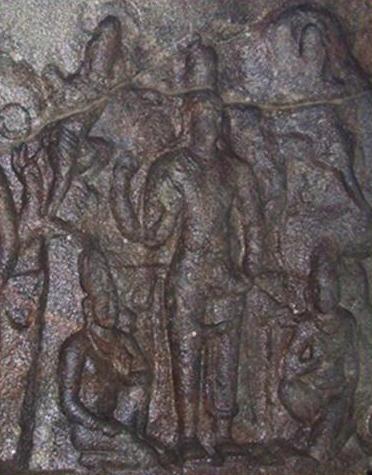 Next to Muruga is Sankaranarayana, depiction of Siva and Vishnu in one form. This sculpture is much wornout due to nature and human vandalism. The right side of the sculpture is shown with the features of Siva in half dress, the front hand in abaya and back hand holding deer, jatabara with cresent moon adorns the head and floating hair is shown upto shoulder. Another half of the sculpture is depicted as Vishnu, front hand in kadiyavalambita and back hand holding sangu, krita makuta adorns the head and pattadai upto ankle is seen. For both the deities dress knots are seen on either side. Sarapalli, makarakundala, bangles and anklets are the ornaments found. Devotees In garudasana on either side of Sankaranarayana, devotees seated are seen with jatamakuta in head, rudraksha mala around neck, elongated ears and yajnopavita. The one to the right of the deity is holding lotus in the left hand and the right hand on the thigh, whereas the one to the left of the deity is holding lotus in the right hand and the left hand is on the thigh. Flying figures On either side of Sankaranarayana above the head flying figures are seen. Both are identified as Chandran and Suryan with the circular halo shown behind their head. Both are seen with makuta and short dress with knots flanking on sides. The one to the right of sankaranarayana is much disfigured. 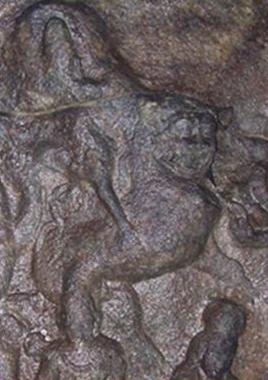 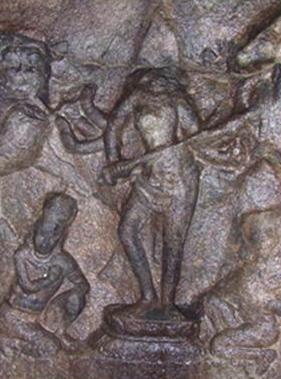 Next to Sankaranarayana sculpture the vehicle of Korravai a Lion is depicted standing in rampant posture. The much disfigured Korravai sculpture is seen standing on a lotus pedestal with the left leg in sama and right leg in trysra. The headless trunk of the deity is clad in pattadai upto the ankle with knots flanking on both sides. Totally eight hands are shown for Korravai with the front hands holding a long sword, whereas the objects in the backhands are not clear. Breast band and bangles are visible. The head of the deer another vehicle of Korravai is shown on the left of Devi. On either side near the foot of Korravai, devotees are seen seated in garudasana. The one to the left of the deity is disfigured whereas the one to the right of the deity is visible with short dress and jatabara. The jatabara is shown as knoted ball and remaining hair floating on sides. An interesting feature to note about the sculpture is the sword seen on the hip. Patrakundala adorns the ears and some ornament around the neck is visible. 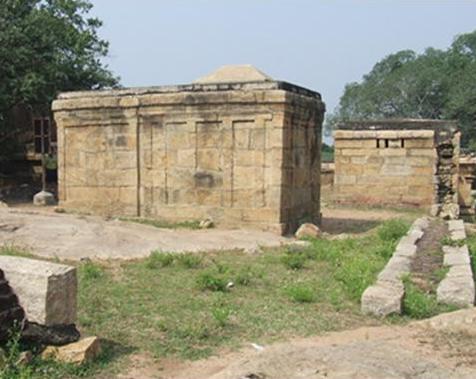 In this temple complex two other structural subshrines are seen facing south. The one found in the northwest corner is a kitchen, and the one found on the north east is the Amman shrine. This structural shrine with cement roof is of later addition without any basement features, has Brahmakanta pilasters on the walls and the roof portion of uttira, vajana, and kapota. The shrine consists of a small mukhamandapa and sanctum of same size. The goddess is standing in sama with the backhands holding the lotus and the front hands in abaya and varam. An inscription of Bahudanya year mentions the deity as Vadivulla Mangai. In the front mandapa a dancing Ganesha sculpture is seen. 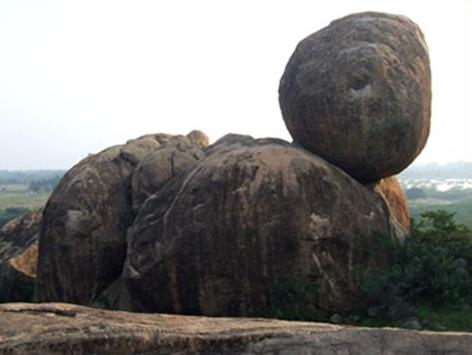 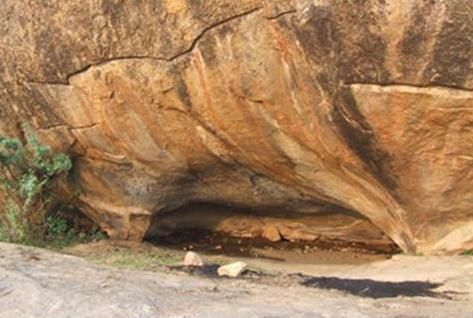 Behind the Alathurmalai, on the rocky hillocks and boulders two natural caverns are found. The one found to the south of the rock cut temples are simple with beds was discovered by the students of Tamil University. Another cavern found to the south east of the rockcut temples, is on the crest of a hillock that can be climbed by a ladder. It was discovered by Dr. Rasamanikkanar Historical Research Center in 2003 during their field study. The space in between the boulder and hillock forms a natural cavern. In a distance view the boulder above the hillock looks as if resting on the tip and a simple thrust can cause a fall. On the roof of the cavern a ridge is cut throughout the edges to prevent the rain water entering inside. Tamil and Telegu inscriptions and drawings of animals are found in the floor whereas a line drawing of male figure on the roof was discovered accidentally during our field study. The male figure holds a club on his left hand and the right hand is in darjani mudra. The rudra club with ornamental arrow edge is resting on his shoulder. The figure is slim with thin mustache, patrakundala, short dress and pointed headgear. The Tamil inscription reads as "கறையூர் ஆலங்காரிக்கு பிச்சும் பிராந்தும் அமனி". The letter style fixes the date not beyond 8th cen A.D. and this inscription has more inner view than it literally reads. Scholars analyzed this inscription and with their views it was published on Varalaru 4th edition. A 19th Century Telegu inscription reads as "மங்காமே சதா சேர்வே" which means Mangan an enduring servant of the Temple. The same text is also found in two other places in Vishnu cave. 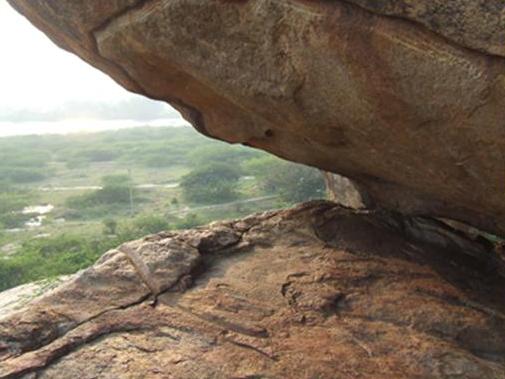 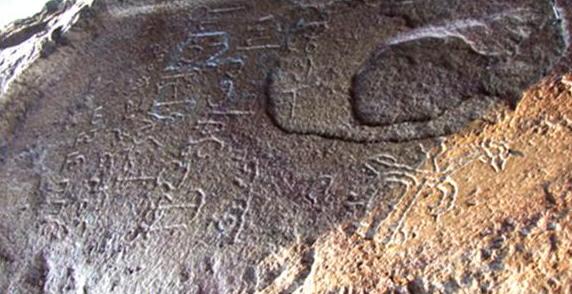 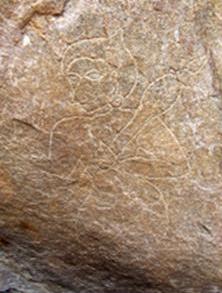 During our field study another interesting inscription was discovered on a rock to the north east of the Shiva cave temple. The inscription reads as "ஸ்ரீகைக்கட்டி". This inscription, which may be dated to the early part of 7th Century AD, also needs further analysis. Apart from this, nearly five inscriptions speak about this cave temple, which are published in Pudukkottai District Inscriptions. The inscription that authenticates the excavator of this cave temple is seen on the pillar in the facade. The 16th regnal year inscription of Dantivarma I dating 804 A.D., mentions that one Videlvidugu Muttaraiyan (a) Kuvavan Sattan carved out the Thiruvalathur malai to form a temple for the deity and consecrated it. The 24th regnal year inscription of Vira Rajendra speaks about the endowments made for the deity in the presence of Parrali nattars, Danattars and Villagers. The inscriptions mention the deity as Vagisvara Nayanar, the village as Thiruvalathur in Keelsengali division. Another inscription mentions Jayasingakulakala valanadu under which Misengilinadu and Kilsengalinadu comes. Inscriptions of Vijayanagar period are also found. With this I conclude the Ist part on Malayadipatti and continue with the Olipathivishnugraham another cave temple in my next account. I thank Mr. Meenakshi Sundaram, ASI Assistant for his help on all matters through out our field study. this is txt file� |

சிறப்பிதழ்கள் Special Issues 

புகைப்படத் தொகுப்பு Photo Gallery 
|
| (C) 2004, varalaaru.com. All articles are copyrighted to respective authors. Unauthorized reproduction of any article, image or audio/video contents published here, without the prior approval of the authors or varalaaru.com are strictly prohibited. | ||